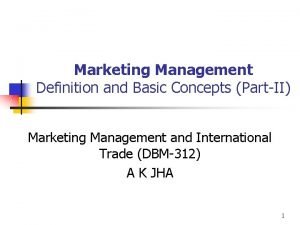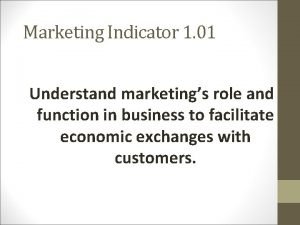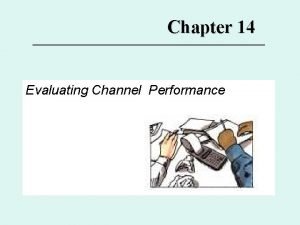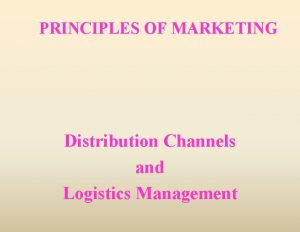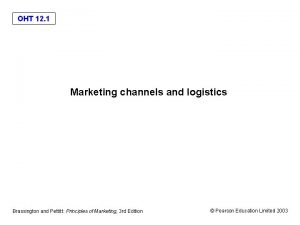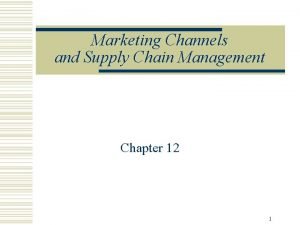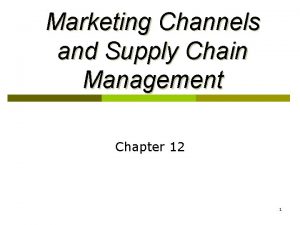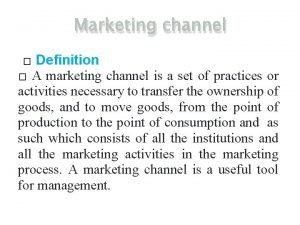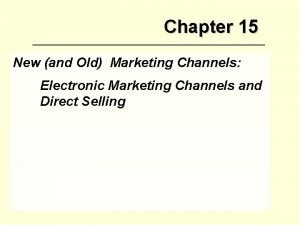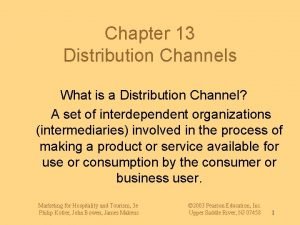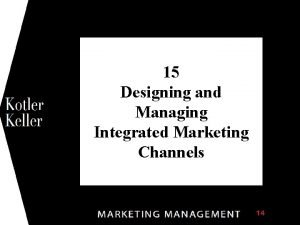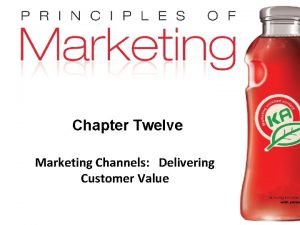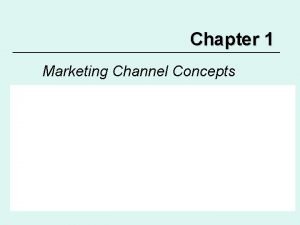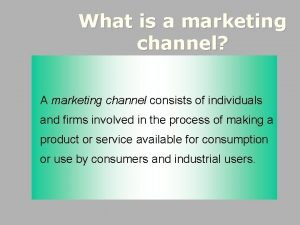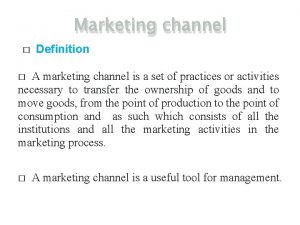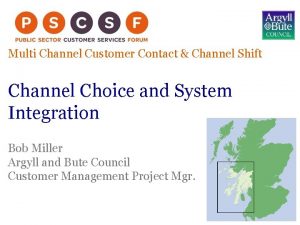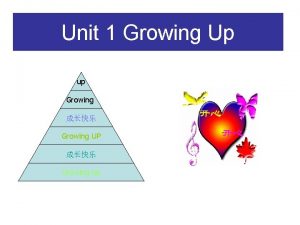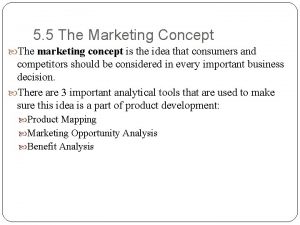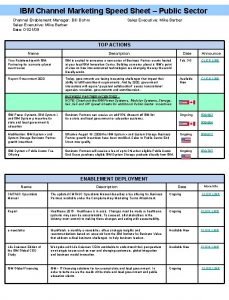Ch 1 Marketing Channel Concept Growing Importance of








































- Slides: 40

Ch. 1 Marketing Channel Concept

Growing Importance of Marketing Channels 1. Explosion of information technology and Ecommerce 2. Greater difficulty of gaining a sustainable competitive advantage 3. Growing power of distributors, especially retailers in marketing channels 4. The need to reduce distribution costs

Growing Importance of Marketing Channels 1. Explosion of information technology and Ecommerce The introduction of E-commerce leads to a new types of middlemen called ‘infomediaries’ along with cyber retailer to connect buyers and sellers via the Internet. E-commerce didn’t change everything, however it is now merging with conventional channels in all business around the world.

Growing Importance of Marketing Channels 2. Greater difficulty of gaining a sustainable competitive advantage “Sustainable competitive advantage” is a competitive edge that cannot be quickly/easily copied by competitors. • The large number of offices makes it easy for clients in thousands of communities in the U. S. as well as Canada and England to visit an offices and get in-person advice and assistance from professional brokers.

Growing Importance of Marketing Channels 3. Growing power of distributors, especially retailers in marketing channels The economic power has shifted from the producers of goods to the distributors of goods especially the power retailers. They play the role of ‘gatekeepers’ act as buying agents for their customers rather than as selling agents for manufacturers.

Growing Importance of Marketing Channels 4. The need to reduce distribution costs Sometimes distribution costs are higher than the manufacturing cost or the cost of raw materials and component parts. Therefore, the cost control in the 21 st century will be marketing channels. Autos Software Gasoline Fax Machines Packaged Foods Distribution 15% 28% 30% 41% Manufacturing 40% 65% 19% 30% 33% Raw Materials and Components 45% 10% 53% 40% 26%

The Marketing Channel Defined • The route taken by a product as it moves from producer to the customer or other ultimate user. • The path taken by the title to goods as it moves through various agencies. • A loose coalition of business firms that have banded together for purposes of trade.

The Marketing Channel Defined • Manufacturer: the movement of the product through these various intermediaries. • Intermediaries (wholesalers/retailers): the flow of the title to the goods. • Consumer: a lot of middlemen standing between them and the producer of the product. • Researcher: the structural dimensions and efficiency of operation.

The Marketing Channel Defined • “The external contactual organization that management operates to achieve its distribution objectives. ” (*a managerial decision-making viewpoint)

The Marketing Channel Defined • external: the marketing channel exists outside the firm (not a part of a firm’s internal organizational structure. )

The Marketing Channel Defined • contactual organization: firms or parties who are involved in negotiatory functions as a product or service moves from the producer to its ultimate user.

The Marketing Channel Defined • operates: suggests involvement by management in the affairs of the channel.

The Marketing Channel Defined • distribution objectives: management has certain distribution goals to achieve.

Use of the Term Channel Manager • Channel manager: anyone in a firm or organization who is involved in marketing channel decision making. • In practice, the job title involves in channel management may vary depends on the firms such as ‘business development manager’, ‘director of channel management’, trade marketing manager’ and etc.

Marketing Channels and Marketing Management Strategy • Marketing management process: a strategic blending of 4 controllable marketing variables (marketing mix) to meet the demands of customers to which the firm wishes to appeal in the light of internal and external uncontrollable variables (marketing environments). Ø Major tasks: to seek out potential target markets and develop appropriate and coordinated 4 Ps strategies to serve those markets in competitive and dynamic environment.

Marketing Channels and Marketing Management Strategy • Marketing channel strategy: one of the major strategic areas of marketing management. Ø Management must develop and operate its marketing channels in such way as to support and enhance the other strategic variables of the marketing mix in order to meet the demand of the firm’s target markets.

Marketing Channels and Marketing Management Strategy • Coors Brewing Company is the nation’s 3 rd largest brewery in the U. S. • The company faced the difficulties: slowed beer consumption, new competitors such as microbreweries and foreign brands. Ø Issues on product strategy: high rates of new product failures, short product life cycles and competitors offer similar products quickly. Ø Issues on price strategy: intense price discounting (beer wars) Ø Issues on promotion strategy: high costs and short-lived of promotion

Marketing Channels and Marketing Management Strategy • Coors Brewing Company came up with the channel strategy: establish stronger relationships with its independent beer distributors than the chief competitors had. • This strategy has been vital to its competitive viability against larger rivals. Strong distributor support also helped Coors to increase its profits.

Channel Strategy versus Logistics Management Marketing mix Product strategy Pricing strategy Promotion strategy Distribution strategy Channel strategy component Logistics management component

Channel Strategy versus Logistics Management Distribution strategy 1 st Channel strategy component 2 nd Logistics management component • Channel strategy is much broader and more basic component than logistics management. • Channel strategy is concerned with the entire process of setting up and operating the contactual organization that is responsible for meeting the firm’s distribution objectives.

Channel Strategy versus Logistics Management Distribution strategy 1 st Channel strategy component 2 nd Logistics management component • Logistics management is more narrowly focused on providing product availability at the appropriate times and places in the marketing channel. • Usually, channel strategy must already be formulated before logistics management can even be considered.

Flows in Marketing Channels The actual physical movement of the product from the manufacturer through all of the parties who take physical possession of the product, from its point of production to final consumers. 1. 2. 3. 4. 5. Product flow Negotiation flow Ownership flow Information flow Promotion flow

Flows in Marketing Channels 1. 2. 3. 4. 5. Product flow Negotiation flow Ownership flow Information flow Promotion flow Manufacturer Transportation company Wholesalers Retailers Consumers

Flows in Marketing Channels 1. 2. 3. 4. 5. Manufacturer Product flow Negotiation flow Buying & selling Ownership flow functions associated with the transfer of Information flow title (right of ownership) Wholesalers Promotion flow Retailers Consumers Negotiation involve a mutual exchange between buyers and sellers

Flows in Marketing Channels 1. 2. 3. 4. 5. Product flow Negotiation flow Ownership flow Information flow Promotion flow Manufacturer Wholesalers Retailers Consumers

Flows in Marketing Channels 1. 2. 3. 4. 5. Product flow Negotiation flow Ownership flow Information flow Promotion flow Manufacturer Transportation company Wholesalers Retailers Consumers

Flows in Marketing Channels 1. 2. 3. 4. 5. Product flow Negotiation flow Ownership flow Information flow Promotion flow Persuasive commu. in the form of ad. , personal selling, sales promotion, and publicity. Manufacturer Advertising agency Wholesalers Retailers Consumers

Distribution strategy 1 st Channel strategy component 2 nd Logistics management component In the context of channel flows concept: • Channel strategy and management involve planning for managing all of the flows • Logistics is concerned almost exclusively with the management of the product flow

Distribution through Intermediaries Economic considerations in determining whether intermediaries will appear in marketing channel: q. Specialization and Division of Labor “Breaking down a complex task into smaller, less complex ones and allocating them to parties who are specialist at performing them, much greater efficiency result. ” (see figure 1. 5 Specialization and Division of Labor Principle: Production vs. Distribution)

Distribution through Intermediaries Economic considerations in determining whether intermediaries will appear in marketing channel: q. Contactual Efficiency The level of negotiation effort between sellers and buyers relative to achieving a distribution objective. • Or it is the relationship between an input (negotiation effort) and an output (distribution objective).

Example of Contactual Efficiency for Granada Guitar Company *Retailers Only Negotiation Effort (Inputs) Estimated Dollar Costs of Inputs Distribution Objective (Outputs) Contactual Efficiency 1, 500 sales visits @ $50 = $75, 000 1, 000 phone calls @ 10 magazine ads @1, 000 = 10, 000 Get 500 music stores to carry new guitar line. Negotiation effort in dollar terms relative to achieving the distribution objective = $88, 000 3 = Total *Wholesalers 3, 000 $88, 000 Negotiation Effort (Inputs) Estimated Dollar Costs of Inputs Distribution Objective (Outputs) Contactual Efficiency 100 sales visits @ $50 = $5, 000 100 phone calls @ 20 magazine ads @1, 000 = 20, 000 Get 500 music stores to carry new guitar line. Negotiation effort in dollar terms relative to achieving the distribution objective = $25, 300 Total 3 = √ 300 $25, 300

Distribution through Intermediaries The use of additional intermediaries will often increase the level of contactual efficiency. § The use of wholesalers has eliminated the need for direct contact with retailers, thereby greatly reducing the number of contacts needed. (see figure 1. 6: How the introduction of additional intermediary reduces the number of contacts)

Channel Structure • The group of channel members to which a set of distribution tasks has been allocated. • • M C M R C M W R C M A W R C (2 -level) (3 -level) (4 -level) (5 -level) A = Agent C = Consumer M = Manufacturer R = Retailer W = Wholesaler

A Typical Portrayal of Channel Structure for Consumer Goods Two-level Three-level Four-level Five-level

Channel Structure • Multi-channel strategy: the firm has chosen to reach its customers through more than 1 channel. • This will result in multi-channel structure because distribution tasks have been allocated among more than 1 channel structure. § Some firms also developed multi-channel structures that include online channels.

Polo by Ralph Lauren Web site Manufacturer http: //www. ralphlauren. com/ Upscale department stores Specialty apparel retailers Consumers Companyowned stores and outlets

Ancillary Structure • The group of institutions (facilitating agencies) that assists channel members in performing distribution tasks. • The role of facilitating agencies is one of providing services to the channel members after the basic channel decisions have already been made.

• One of the world’s leading manufacturers of power tools. B&D farm out the nonnegotiatory tasks to facilitating agencies (the ancillary structure) as the following: Ø It uses the common carriers to transport its power tools to industrial distributors. Ø It uses the commercial insurance companies to protect against risks while the products are transit. Ø It uses independent advertising agencies to promote its products.

Homework 1. What are the “Channel Participants”? Explain. 2. What are the “Environment of Marketing Channels”? Explain.

1 st Quiz 1. Explain 2 reasons make marketing channel become more important. 2. Explain what is marketing channel. 3. Explain what is ancillary structure. 4. Explain flows in marketing channel. 5. Explain the channel strategy and logistics management. 6. In the case of Amway, what happened to its marketing channel?
 Facilitating agencies in marketing channel
Facilitating agencies in marketing channel Marketing concept
Marketing concept Importance of marketing concept
Importance of marketing concept Perbedaan pemasaran dan penjualan
Perbedaan pemasaran dan penjualan Definition of multi channel retailing
Definition of multi channel retailing Signal space analysis in digital communication
Signal space analysis in digital communication N channel p channel
N channel p channel Channel member performance audits:
Channel member performance audits: Through channel marketing automation
Through channel marketing automation Place channel
Place channel 12 principles of logistics
12 principles of logistics Partner marketing concierge services
Partner marketing concierge services Marketing channel structures
Marketing channel structures Marketing channel structures
Marketing channel structures Marketing channel strategy
Marketing channel strategy Channel management decisions
Channel management decisions Vertical system
Vertical system Channel definition in marketing
Channel definition in marketing Global marketing channels and physical distribution
Global marketing channels and physical distribution What is channel design with examples
What is channel design with examples Specialized channel participants
Specialized channel participants Electronic marketing channel
Electronic marketing channel Distribution channels
Distribution channels Promotion through the marketing channel
Promotion through the marketing channel Direct vs indirect marketing channels
Direct vs indirect marketing channels Classification of channel participants
Classification of channel participants Indirect marketing channel
Indirect marketing channel Evaluating the variables affecting channel structure
Evaluating the variables affecting channel structure Integrated marketing channel system
Integrated marketing channel system Specialty channels marketing
Specialty channels marketing Channel levels in marketing
Channel levels in marketing Channel levels in marketing
Channel levels in marketing Channel levels in marketing
Channel levels in marketing Merchant wholesalers
Merchant wholesalers Marketing channels and value networks
Marketing channels and value networks Marketing channel concepts
Marketing channel concepts Channel marketing software
Channel marketing software Electronic marketing channel
Electronic marketing channel International marketing channel
International marketing channel Marketing channel task
Marketing channel task Behavioral processes definition
Behavioral processes definition

